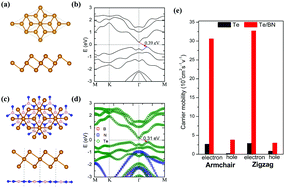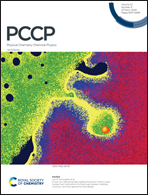Enhanced carrier mobility and tunable electronic properties in α-tellurene monolayer via an α-tellurene and h-BN heterostructure†
Abstract
Using first-principles calculations within density functional theory, we explore the electronic properties of the α-tellurene/h-BN (Te/BN) heterostructure. We find that the type-I van der Waals (vdW) Te/BN bilayer exhibits an indirect semiconductor property with a bandgap of 0.59 eV, in which both the valence band maximum and conduction band minimum originate from the tellurene monolayer. The very weak interaction between α-tellurene and h-BN monolayers is demonstrated by the small charge transfer between the interlayer. More strikingly, we find that the carrier mobilities in the Te/BN bilayer can reach up to 104 cm2 s−1 V−1, one order of magnitude larger than those in tellurene. The underlying physics is that the Te/BN bilayer dramatically increases the in-plane stiffness as well as reducing the deformation potential compared with the tellurene monolayer. Additionally, we also show that the electronic properties of the Te/BN bilayer can easily be tuned by introducing defects or dopants in the BN monolayer. For instance, the B vacancy makes the Te/BN bilayer undergo the transition from semiconductor to half-metal. Our findings will broaden the potential application of tellurene and provide theoretical guidance for the relative experimental studies on 2D heterobilayers.



 Please wait while we load your content...
Please wait while we load your content...